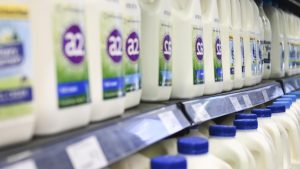
Consumers often look to Danone’s products — a variety of yogurts, plant-based dairy and bottled water — for a better-for-you meal, snack or beverage.
But that doesn’t mean there isn’t room for improvement, Miguel Freitas, Danone’s vice president of scientific affairs, said in an interview on the sidelines of this week’s White House Conference on Hunger, Nutrition and Health.
So leading up to the conference, Danone committed to do just that. The company says that by 2030, 95% of its products targeted at children will have 10 grams or less of sugar per 100 grams, and 70% of its plant-based dairy beverages will have improved nutrient densities.
The focus of the day-long conference was talking about ways government and the private sector can work together to end hunger in the United States and improve residents’ overall health through better nutrition. The Biden administration set a goal of reaching this aim by 2030 and outlined a strategy to take advantage of federal programs and funding to make these outcomes available. Several food companies, industry organizations, charitable groups, grocers and private equity groups issued their own commitments to help these efforts.
Some of these promises are like Danone’s: a pledge to make products healthier and a financial commitment. In addition to product improvements, Danone also committed $22 million — $15 million to improve nutrition education for consumers and healthcare providers, $3 million to improve access and affordability of health-promoting and nutrient-dense products in underserved communities, and $4 million to enhance nutrition and food security research.
Freitas said Danone’s commitment came from conversations with its R&D department, as well as looking at the landscape of hunger and nutrition issues in the United States. A lot of the focus of ending hunger and solving nutritional issues is on children.
“It’s really there where we should start, so we looked a little bit closer at children’s products, and where we could improve,” Freitas said.
Globally, Danone is trying to get all of its products for children down to the 10 grams of sugar per 100 grams of product threshold, Freitas said. This is not an easy task. Yogurt varieties often have sugary components, even when there isn’t much sugar added. Dairy products have naturally occurring sugars, which may increase as they are fermented into yogurt. And the fruit often used to flavor yogurt also has natural sugars. The upshot, Freitas said, is that simple reformulations using other sweeteners or different combinations of ingredients are not necessarily enough to help Danone meet this goal.
Danone’s nutrition scientists are using other tools to get there, Freitas said. They’ve been looking at the fermentation process that makes the yogurt itself. Danone scientists have found different bacteria actually can create a yogurt that tastes sweeter without adding sugars. Work will continue on that front, he said.
As far as plant-based beverages go, Freitas said Danone wants them to be as much like dairy milk in terms of nutrients as possible. On its own, this can be difficult, he said, because the only plant-based protein commonly used in plant-based beverages that has comparable proteins and amino acids on its own is soy. And while that’s great, soy is also a common allergen and not necessarily something everyone wants to consume. Freitas said if Danone’s portfolio can contain more plant-based beverages that have 80% the protein and nutrients of dairy milk, they would be doing well.
Danone is working toward that goal the same way non-meat-eating consumers do when they choose what to eat, Freitas said.
“We can do that by mixing different proteins in sources, very much like vegetarians do and vegans do with beans and rice,” Freitas said. “That’s pretty much the same principle.”
Danone has been working toward this increased nutritional profile for a while. Last year, they launched the beginnings of their “plant based 2.0” platform. Silk Nextmilk and So Delicious Wondermilk were carefully formulated to closely mimic the taste, texture and nutritional qualities of dairy.
Freitas said Danone’s funding commitments will help more consumers be able to access the products they are making. While it is important for the company to put money into actual programs to help underserved communities get more access to nutritious food, as well as continuously fund research into food science and nutrition, consumers need to know more about why products like yogurt and plant-based dairy are beneficial dietary choices, he said.
Danone’s largest financial commitment is in education because it helps inform consumers to make better choices for their health. Freitas said they have completed in-store pilot programs with retailers to push educational information about their products to consumers. But the company’s real focus right now are doctors.
“Our goal is to reach as many healthcare professionals as possible with information about healthy nutrition and how our brands can be part of the solution to this problem,” he said.
Danone is especially interested in reaching pediatricians and dietitians with this message, as both of those professionals tend to have high amounts of credibility, he said.
While Danone has been on a consistent path to improve its products and their nutritional value, Freitas said he is glad to see the national spotlight focusing on food and health. It’s been more than 50 years since the last White House-level conference on nutrition, but those discussions resulted in big policies, including nutrition and ingredient labeling improvements and expanding the School Lunch Program and what is now known as the Supplemental Nutrition Assistance Program.
The way many people in the United States eat today contributes to several negative health outcomes, including obesity and Type 2 diabetes, Freitas said. But, after the conference is over, he said he hopes it “raises more awareness, and has companies and the government more focused on health and nutrition, and make sure that we start reverting a little bit the crisis that we are [in] today with the American diet and the consequences, which is diet-related diseases.”

























